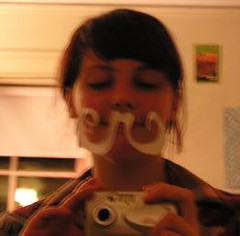Popfun
"What happened was that these emotionally charged images from the mass media dramatically reduced aesthetic distance...something intimate and simple was offered. An appeal to common experience was central to the first phase of Pop art."
"The basic assumption was that our idea of nature had changed because of the bombardment of our sense by the signs, colors, and lights of the mass media. Hence it was supposed to be possible to create an analogue of the man-made environment, which we all participate in, by means of a nonverbal but highly topical imagery."
"It wasn't the sunset the abstract painters wanted but the flow of neon, the dazzle of high-style fashion, the envelopment of big-screen cinema, realized not by one-to-one references but by color and scale."
-Pop since 1949, Nigel Whiteley
(Do you guys have any idea how much I love the blink tag? Perhaps it's best if I keep my shameful secret under wraps.)
Attempts to "reduce aesthetic distance" from artworks are always very interesting to me, be they literary (as in violent or highly sexualized novel [examples of which Shane and I, along with the rest of the members of EL176.4 are fairly swimming in this semester]), visual (Pop art), musical (ambient and experiemental?), or "other." The assumption that "our idea of nature has changed," especially in the context of mass media and technological development, seems to suggest that "our" conception of ourselves as participants in/observers of artworks has changed. Is that so? How much
can we say that the mindset of any given observer/participant differs from that of another (in particular, across historical period). Isn't the whole "mind reeling from technological advances" thing a given by now (er...by 1949)? I suppose I haven't much of a point to make. Just saying, is all.
"Mailing lists and the BBS (bulletin board system) were more than structures for distribution and promotion: They were simultaneously content and community. Like Andy Warhol's Factory, the people as well as the methods of production and distribution were all part of the project's meaning."
-Web Work: A HISTORY OF INTERNET ART, Rachel Greene
I just wanted to throw this quote "out there" (oh ho ho, the digital abyss) to get a discussion started on internet communities, specifically net.art communities. How do these differ from sites of collaboration/conversation employed by "traditional" media artists? What about digital sites being used for "non-artistic" purposes? Do they have the potential for transformation (in the eyes/other sensory organs of the observer or otherwise) into art?
"The basic assumption was that our idea of nature had changed because of the bombardment of our sense by the signs, colors, and lights of the mass media. Hence it was supposed to be possible to create an analogue of the man-made environment, which we all participate in, by means of a nonverbal but highly topical imagery."
"It wasn't the sunset the abstract painters wanted but the flow of neon, the dazzle of high-style fashion, the envelopment of big-screen cinema, realized not by one-to-one references but by color and scale."
-Pop since 1949, Nigel Whiteley
(Do you guys have any idea how much I love the blink tag? Perhaps it's best if I keep my shameful secret under wraps.)
Attempts to "reduce aesthetic distance" from artworks are always very interesting to me, be they literary (as in violent or highly sexualized novel [examples of which Shane and I, along with the rest of the members of EL176.4 are fairly swimming in this semester]), visual (Pop art), musical (ambient and experiemental?), or "other." The assumption that "our idea of nature has changed," especially in the context of mass media and technological development, seems to suggest that "our" conception of ourselves as participants in/observers of artworks has changed. Is that so? How much
can we say that the mindset of any given observer/participant differs from that of another (in particular, across historical period). Isn't the whole "mind reeling from technological advances" thing a given by now (er...by 1949)? I suppose I haven't much of a point to make. Just saying, is all.
"Mailing lists and the BBS (bulletin board system) were more than structures for distribution and promotion: They were simultaneously content and community. Like Andy Warhol's Factory, the people as well as the methods of production and distribution were all part of the project's meaning."
-Web Work: A HISTORY OF INTERNET ART, Rachel Greene
I just wanted to throw this quote "out there" (oh ho ho, the digital abyss) to get a discussion started on internet communities, specifically net.art communities. How do these differ from sites of collaboration/conversation employed by "traditional" media artists? What about digital sites being used for "non-artistic" purposes? Do they have the potential for transformation (in the eyes/other sensory organs of the observer or otherwise) into art?


0 Comments:
Post a Comment
<< Home